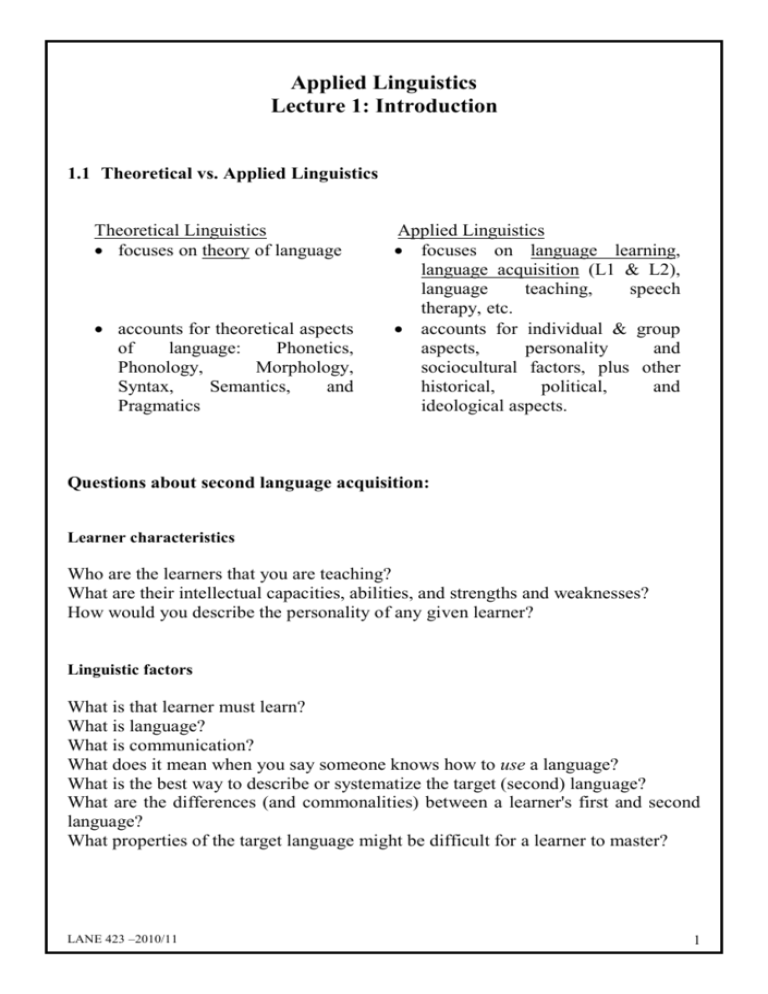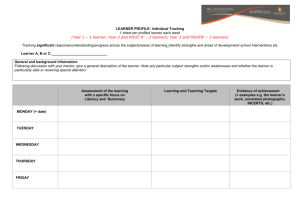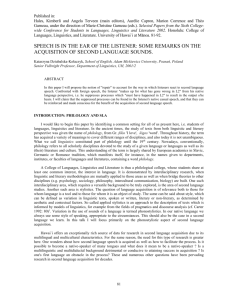نموذج حذف وإضافة
advertisement

Applied Linguistics Lecture 1: Introduction 1.1 Theoretical vs. Applied Linguistics Theoretical Linguistics focuses on theory of language accounts for theoretical aspects of language: Phonetics, Phonology, Morphology, Syntax, Semantics, and Pragmatics Applied Linguistics focuses on language learning, language acquisition (L1 & L2), language teaching, speech therapy, etc. accounts for individual & group aspects, personality and sociocultural factors, plus other historical, political, and ideological aspects. Questions about second language acquisition: Learner characteristics Who are the learners that you are teaching? What are their intellectual capacities, abilities, and strengths and weaknesses? How would you describe the personality of any given learner? Linguistic factors What is that learner must learn? What is language? What is communication? What does it mean when you say someone knows how to use a language? What is the best way to describe or systematize the target (second) language? What are the differences (and commonalities) between a learner's first and second language? What properties of the target language might be difficult for a learner to master? LANE 423 –2010/11 1 Learning processes How does learning take place? How can a person ensure success in language learning? What cognitive processes are utilized in second language learning? What kinds of strategies are available to a learner? Age and acquisition When in the life of a learner does second language learning take place? Are children better learners than adults? If so, in what way does the age of learning make a difference? How do the cognitive and emotional changes of childhood and young adulthood affect language acquisition? Instructional variables Do all people learn a language equally successfully? If not, what are the ingredients for success? Purpose Why are the learners attempting to acquire the second language? What are their purposes? Are they motivated by the achievement of a successful career, or by passing a foreign language requirement, or by wishing to identify closely with culture and people of the target language? 1.2 What is language? Is there one definition for language? “systematic communication by vocal symbols” (cited in Concise Columbia Encyclopedia (1994, p.479) LANE 423 –2010/11 2 “Language is a complex, specialized skill, which develops in the child spontaneously without conscious effort or formal instruction, is deployed without awareness of its underlying logic, is qualitatively the same in every individual, and is distinct from more general abilities to process information or behave intelligently” (cited in Pinker’s The language Instinct (1994, p.18)) “Language is a system of arbitrary conventionalized vocal, written, or gestural symbols that enable members of a given community to communicate intelligibly with one another”. Textbook definition (cited in Brown, 2002, p. 5) number of possible definitions yields: 1. 2. 3. 4. 5. 6. 7. 8. Language is systematic. Language is a set of arbitrary symbols. Those symbols are primarily vocal, but may be visual. The symbols have conventionalized meanings to which they refer. Language is used for communication. Language operates in a speech community or culture. Language is essentially human. Language is acquired by most people in the same way. 1.3 What is teaching? “showing or helping someone to do something giving instructions, guiding in the study of something, proving with knowledge, causing to know or understand” Textbook definition (Brown, 2002, p. 5) Teaching cannot be defined apart from learning. Teaching is guiding and facilitating learning, enabling the learner to learn. LANE 423 –2010/11 3 1.4 What is learning? “To gain knowledge, comprehension, or mastery through study” American Heritage Dictionary (1989, p. 720) “Learning is relatively permanent change in a behavioral tendency and is the result of reinforced practice” Kimble and Garmezy (1963, p. 133) “to impart knowledge or skill to someone” American Heritage Dictionary (1989, p. 1246) “Showing or helping someone to learn how to do something, giving instructions, guiding in the study of something, providing with knowledge, causing to know or understand” Brown (2000, p. 7) number of possible definitions yields: 1. 2. 3. 4. 5. 6. 7. Learning is acquisition or “getting.” Learning is retention of information or skill. Retention implies storage systems, memory, cognitive organization. Learning involves active, conscious focus on acting upon events outside or inside the organism. Learning is relatively permanent but subject to forgetting. Learning involves some form of practice. Learning is a change in behavior. Reading: Brown (4th ed.): 1-8 Brown (5th ed.): 1-9 LANE 423 –2010/11 4









